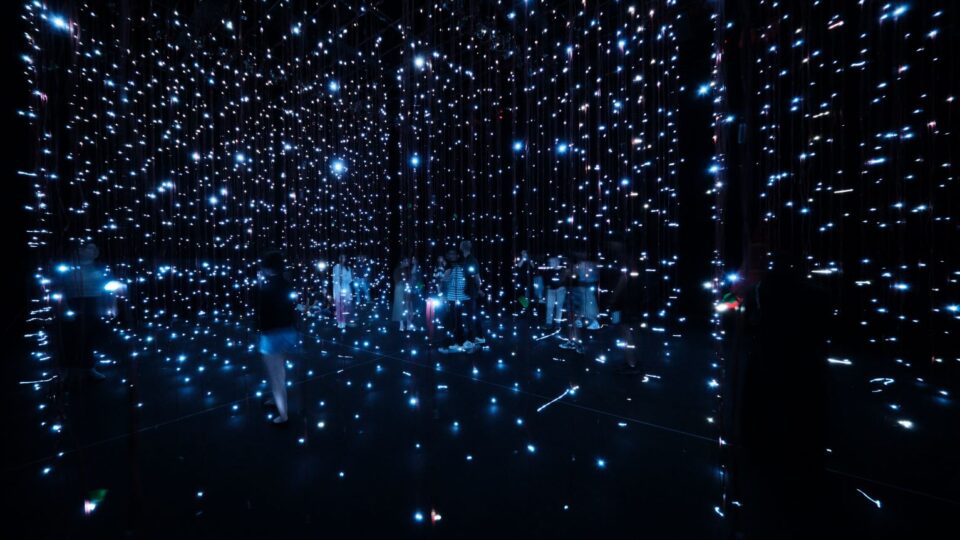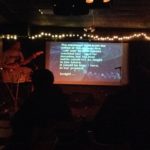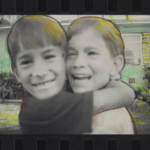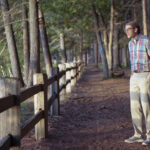Hancher Auditorium’s Infinite Dream festival ended with a glimmer on October 21 with Andrew Schneider’s NOWISWHENWEARE (the stars). I went on October 20th, and came to it early, and secured an interview with Schneider which will be featured throughout this article.
As soon as you enter the dark room that you were led into for this experience, two things immediately stick out to you; the massive scale of the lights, and the wonderfully diverse sound set up. At different points of the room you could hear questions being asked by a recording of Schneider like “Where are you? Like now, without giving names of places, like spatially where are you right now?” You can hear Japanese news broadcasts, nature ambience, or Billie Holiday singing. There’s no outage of different noises, which partially reflects the reason he made this piece in the first place.
“The history of my entire life, everything I’ve seen, lived, touched, it’s really an amalgamation of everything I’ve ever been thinking about. From quantum mechanics, to the cosmological horizon, to our place in the cosmos, to what makes up our daily lives, to, like, solipsism, to, like, grief, grief of every passing moment, the grief of big things, and that was all. I make theater usually, and I have always wanted to make something that is less about the person on stage that you are watching, and more about you as the audience member coming into the space, like you now, but I don’t know you so, I can’t make assumptions.”
“I just set myself out to make something design focused. You’re not watching somebody, but you’re watching yourself watch something perceptually. That was the task I set myself out to do, and that coincided with the pandemic happening which meant that, you know, the whole business of a bunch of people being in a room together which is what theater is about, that was out the window. So, it all came together at the right time.”
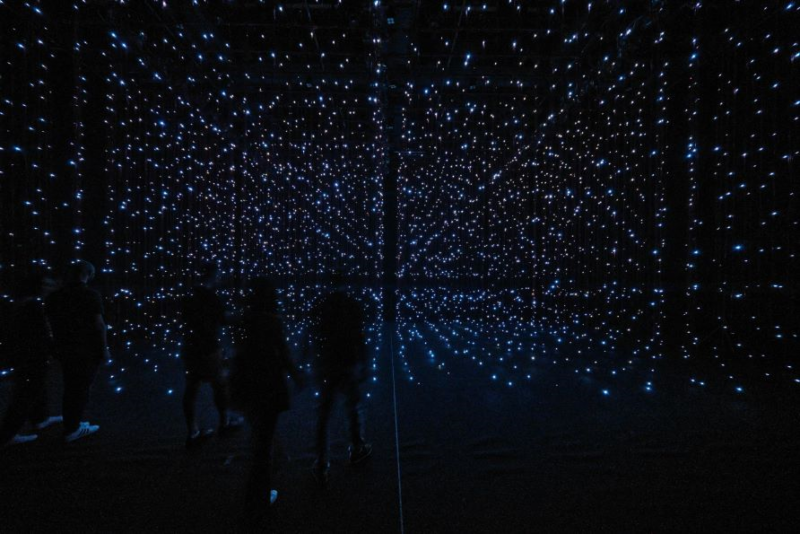
Image via Hancher Auditorium
The mention of grief is very important in the whole of the work, but I will get to that shortly. After the pre-show mix of noise ends, a wonderful light show begins. It mixes in with natural ambience as background noise, with some limited amounts of music to create a very immersive experience. The idea of other people being around is completely ignored by your mind while you’re trying to keep an eye on the shifting patterns. Sometimes it feels random, other times it feels like rain is falling from the sky, a spotlight being shown around, or even waves of an ocean. It’s very enveloping, which really plays into Schneider’s first look into making art: creating unique ways to pull in an audience.
“When I was a kid, my parents had a VHS camcorder. That was my best friend. I mean, me and my best friends had that as our other best friend. We would make parody videos, we would, like, try to do cool in-camera editing. Stuff like that, and so I was super into photography. I was also super into setting up my room with all these little strings and pulleys to turn on and off the lights, and open drawers to automate everything. When I got to the time for college, it was like, ‘Well, I’m either gonna go for black and white photography, like film photography, or musical theater.” I could use the dark room if I went to theater school. If I go to photo school, I can’t use the stage, you know? So, I went to theater school, but I always kept this love of photography and stage composition and design.”
“I was doing a bunch of musical theater performances. Out of college, I lived in New York City, and I was getting work, but I thought, ‘This is weird, we’re just telling the same stories over and over,’ and I wanted to see if we can tell different stories. I had a deep mistrust of technology at the time, and because of that, I went to school for technology to figure it out from the inside out. I had my parents, so this was in 2003. Cell phones had just come out. I grew up in the generation before cell phones were a thing. My partner at the time texted me, ‘I love you’ and I was like, you can’t say that through text messages. It was so new. You have to like write a love letter for that. I thought it was the downfall of civilization. I mean, it might still be. It all came together also, like my love of technology, my hate of technology, I needed to explore it from the inside out.”
A trailer for NOWISWHENWEARE (the stars)
One of the most striking things about this work is the fact that little room is left for interpretation. Not that interpretation can’t exist in this piece, but it’s very obviously about our place in the universe with a centerpiece of grief. Near the end of the show, the lights essentially stop. We’re left with a singular light up near the ceiling. Schneider talks to us through the last moments of a person’s life, “One last laugh at old memories. That laugh turns to a smile which fades into a blank stare that doesn’t remember what it was laughing about.” Then the light goes out. For about 15 seconds you are left in the dark, with dead quiet, and only your thoughts, and gives a bit of reflection time before the lights start to enter back into the space. You are focused in that one moment in time, a theme in which Schneider’s work is inspired.
“I find a lot of inspiration in James Turrell stuff. Mostly because he just draws up a frame around a phenomenon that’s already there. Like his sky spaces. It’s literally just a hole in the ceiling, but he does it with such care, and such attention to detail of how you’re going to see it, and how you’re going to come to it. It’s the context around it. He plays with the audiences perceptions so much, but in such a simple way. He’s like one of the hottest artists in the world. He just draws a frame around natural phenomena, like you’re looking at light. That’s all that’s all you’re looking at. It’s just so beautiful and simple.”
“His stuff is super inspiring. But I also like a lot of narrative stuff that I’m just not good at. I find a lot of inspiration in like folk art, I think. A lot of inspiration from folk art because it is what it is, and it doesn’t pretend to be something else. It’s not that it doesn’t have a super intellectualized idea behind it. It can just be like a way of communicating or caring for others, or a way of recording your own history. I find that methodology, like it’s sort of anti-establishment, and sort of like a gallery of white box art. It’s weird because Turrell is super white box art but then includes elements of folk art. Maybe isn’t really the confluence of both those things, but like art doesn’t need to be in a museum for it to be art. It doesn’t matter what others think, it’s how it makes you feel.”

One of James Turrell’s pieces. Image via Copenhagen Contemporary
I ended up watching the experience twice, each time reflecting on a different grief in my life. It was healing to think and mull over these thoughts. During my second watch I changed positions to really take in another view of the show, and once again I was mesmerized. I could’ve stayed for a third or fourth or fourteenth watch, it just felt so meaningful. There was a bluntness in its goals which was really refreshing. Just to have a goal to visualize the grief of every passing moment and our place in this unending universe, it’s a big task. This was pulled off with grace and thoughtfulness, which is really owed to his work flow, which I had asked him about.
“For sure enough, I know how to make stuff small, and then the first time I made something bigger, I was like, ‘I’m gonna make it small.’ The first time I ever made one was in 2015 and that was like a tour of the world. It’s cool, but it started in my apartment, just me on a laptop. Doing some creative coding, playing around with Arduino in trying to get the lights to turn on and off, and then writing some stuff to say on a microphone, automating everything. I realized though I can do this on a small scale. I don’t have the infrastructure to make something at the theater, but I can, if I can get somebody interested. I can go to the theater, use their lights, and tie my stuff into their stuff.”
“I spent my adult life basically figuring out what do I need to get good at? What infrastructure do I need in order to make the work that I want to make? What am I going to rely on for an institution to bring this to the table? I did as much as I need to, and then I come to places like this, and I scale it up. I made this piece and fabricated it all in my studio, which has like, nine foot ceilings. Here at Hancher, there’s 70 foot ceilings. Typically I don’t have access to those things. I do little tests, so I knew it was about scaling up for me. I made the 9 foot high, 10 foot wide version. Then someone was like, ‘This is cool, can you make a bigger thing?’ So, then I fabricated it and provided the space that we tested in the bigger space. It kept going on like that until we got to a place like this.”
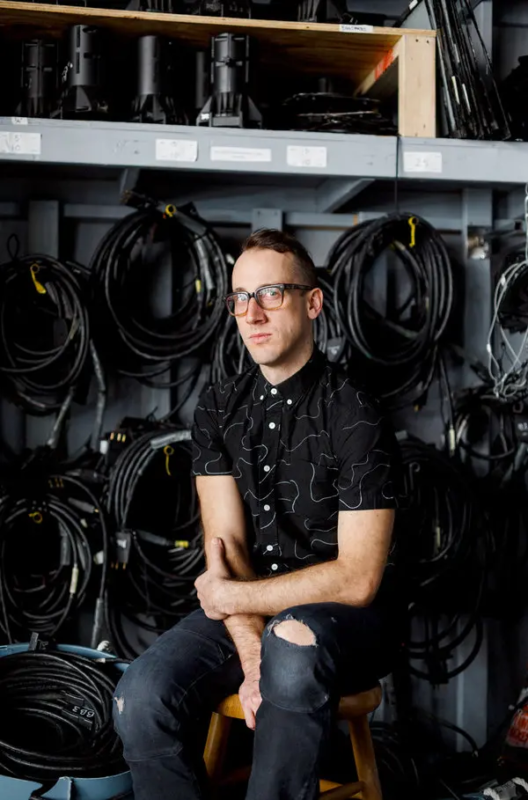
Andrew Schneider. Image via The New York Times
The interesting thing to me is how this was used to end off Hancher’s Infinite Dreams festival. They described it as an exploration into “the complex fabric of the American Story, our grand accomplishments, disruptive failures, and remarkable potential for excellence.” This work is a grand accomplishment in my eyes, but beyond that, it goes into the minute thread of the “American Story,” for each individual citizen. Other acts in this festival covered parts of said story, but this went beyond the story to the personal level. It reached each and every one of us, in a blanket statement sort of way. It both covered experiences that apply to everyone, while feeling very personal. When asked about why he came to Iowa City, Schneider replied with this;
“Aaron and Andre, the folks who are sort of in charge of this place, heard about the show. We had a bunch of conversations and thought this is actually a great opportunity and a great place to bring it. So, I did a site visit here and I checked out all the spaces. We were going to do it in this lounge at one point, but instead we decided to use it as the intro, and then we can actually go use the bigger space for this show, but the reception here has been amazing from the community.”
“I’m from Milwaukee, so it’s really nice to be back in the Midwest, because I grew up thinking that there’s like a right way to see art. I thought there’s like a proper way to see it and like there’s a proper way to interpret it. I thought I was stupid for most of my life because I don’t get metaphors. So, I like making things now that aren’t intellectualized. They just kind of wash over you, that you can bring your full self to, and you can interpret however you want. It’s been wonderful because before this, we were in Abu Dhabi in the United Arab Emirates, and it’s just been so great. We brought the installation to these super diverse audiences. It shows how we’re all different, but we are all the same as well.”
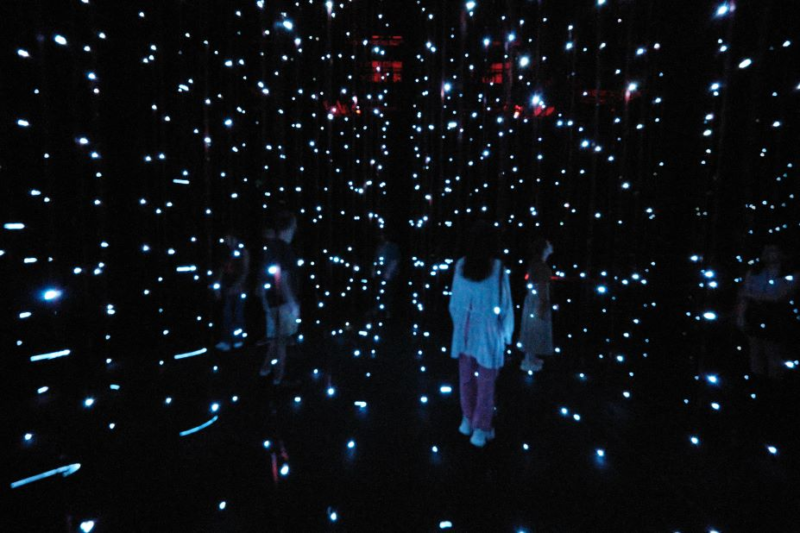
Image via Hancher Auditorium
Due to the themes of the show, I asked him about how he keeps himself refreshed to make every moment last, and his response was very interesting;
“Take big breaks from art, that’s for sure. Mostly, I go to the desert like in Utah, and I try not to see another human being for five days, at least. That’s a total reset for me, and I always think I’m gonna go into the desert, and have all these ideas about projects, but I never do. I don’t have ideas about projects. Specifically, I’d have ideas about race, the planet, and the existence of consciousness, and then I bring that to the project later. That’s all of what I end up making my work about. Anyway, it’s just like, I tried to re-understand how to listen. For me as an artist, that’s the biggest skill that I’m trying to constantly relearn.”
I followed up this question with one about what he thought was the best advice to pass on to our readers at home. This is what he had to say;
“Pieces of advice? I would say failure is one of the greatest teachers. It sounds so cliche, but I’ve learned so much more from failing. I’ve actually grown to enjoy failure. It’s like now I don’t have to do that idea ever again. Once you realize that like the first ten things that you do are not going to be good, it’s such a relief because it’s not so precious. Now I know that the first ten or fifteen things that I do are not going to be good, but I’m getting at an idea, and just have to keep digging.”
Andrew Schneider brought through a wonderful spectacle to the Hancher Auditorium, and the Iowa City community, providing reminders and insights to our existences. If you ever get the chance to see NOWISWHENWEARE (the stars), take that opportunity and run with it.

